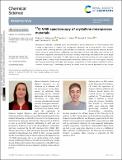Files in this item
17O NMR spectroscopy of crystalline microporous materials
Item metadata
| dc.contributor.author | Ashbrook, Sharon E. | |
| dc.contributor.author | Davis, Zachary | |
| dc.contributor.author | Morris, Russell | |
| dc.contributor.author | Rice, Cameron M. | |
| dc.date.accessioned | 2021-03-19T17:30:10Z | |
| dc.date.available | 2021-03-19T17:30:10Z | |
| dc.date.issued | 2021-02-25 | |
| dc.identifier | 273050188 | |
| dc.identifier | ac88981d-4c01-47b3-b0a5-c95f2ddfcf21 | |
| dc.identifier | 85104179227 | |
| dc.identifier | 000640322400002 | |
| dc.identifier.citation | Ashbrook , S E , Davis , Z , Morris , R & Rice , C M 2021 , ' 17 O NMR spectroscopy of crystalline microporous materials ' , Chemical Science , vol. Advance Article . https://doi.org/10.1039/D1SC00552A | en |
| dc.identifier.issn | 2041-6520 | |
| dc.identifier.uri | https://hdl.handle.net/10023/21672 | |
| dc.description | The authors would like to thank the ERC (EU FP7 Consolidator Grant 614290 EXONMR and Advanced Grant 787073 ADOR) and EPSRC (EP/N509759/1) for a studentship for CMR. | en |
| dc.description.abstract | Microporous materials, containing pores and channels ofsimilar dimensions to small molecules have a range of applications incatalysis, gas storage and separation and in drug delivery. Their complexstructure, often containing different types and levels of positional,compositional and temporal disorder, makes structural characterisationchallenging, with information on both long-range order and the localenvironment required to understand the structure-property relationships andimprove the future design of functional materials. In principle, 17O NMR spectroscopy should offer an ideal tool, with oxygen atoms lining the poresof many zeolites and phosphate frameworks, playing a vital role in host-guestchemistry and reactivity, and linking the organic and inorganic components ofmetal-organic frameworks (MOFs). However, routine study is challenging,primarily as a result of the low natural abundance of this isotope (0.037%), exacerbatedby the presence of the quadrupolar interaction that broadens the spectral linesand hinders the extraction of information. In this Perspective, we willhighlight the current state-of-the-art for 17O NMR of microporousmaterials, focusing in particular on cost-effective and atom-efficientapproaches to enrichment, the use of enrichment to explore chemical reactivity,the challenge of spectral interpretation and the approaches used to help thisand the information that can be obtained from NMR spectra. Finally, we willturn to the remaining challenges, including further improving sensitivity, thehigh-throughput generation of multiple structural models for computationalstudy and the possibility of in situand in operando measurements, andgive a personal perspective on how these required improvements can be used to helpsolve important problems in microporous materials chemistry. | |
| dc.format.extent | 21 | |
| dc.format.extent | 1598270 | |
| dc.language.iso | eng | |
| dc.relation.ispartof | Chemical Science | en |
| dc.subject | QD Chemistry | en |
| dc.subject | T-NDAS | en |
| dc.subject.lcc | QD | en |
| dc.title | 17O NMR spectroscopy of crystalline microporous materials | en |
| dc.type | Journal item | en |
| dc.contributor.sponsor | European Research Council | en |
| dc.contributor.sponsor | European Research Council | en |
| dc.contributor.institution | University of St Andrews. School of Chemistry | en |
| dc.contributor.institution | University of St Andrews. EaSTCHEM | en |
| dc.identifier.doi | https://doi.org/10.1039/D1SC00552A | |
| dc.description.status | Peer reviewed | en |
| dc.identifier.grantnumber | 787073 | en |
| dc.identifier.grantnumber | 614290 - EXONMR | en |
This item appears in the following Collection(s)
Items in the St Andrews Research Repository are protected by copyright, with all rights reserved, unless otherwise indicated.

